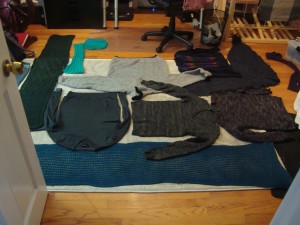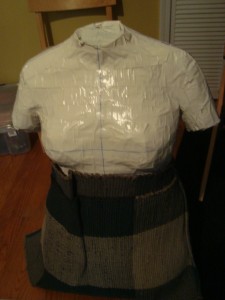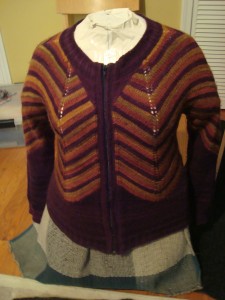Sat 30 Aug 2014
With fall weather fast approaching, it is again time for the autumn Washing of the Wool. This is a semi-annual event around here; everything gets one good wash on the way into storage in the spring and on the way out of it in the fall.
I wish I could cut that down to just one washing in the spring, since you wouldn’t think that wool would need another wash after sitting in a plastic bin for the summer, but I am quite allergic to dust mites and often find that natural fibers need a wash after being stored for a month or two. I’ve also been shocked at how much extra dirt comes out on a second washing, especially for sweaters that we wear all the time. At first I thought it was just dye leaking, but even our natural fibers managed to get the water pretty dirty, considering that they were washed thoroughly (or so I thought) just before they were put away.
The autumn washing also gives me a chance to go over everything with a careful eye to check for pulls, stains, and (heaven forbid) nibbles from insects that might have happened in the previous year of use. This year, I am also putting my Gleaner to good use depilling some fabrics that sorely need it.
The Washing of the Wool started out as a small, informal event, but has grown in size each year that I’ve done it. At this point, I think it merits capital letters in the title. For the past week, my office floor has looked like this almost every night:
The colors vary, of course, but I’ve managed to cover the whole floor with knitted items several times over. (I’m also washing my commercial wool sweaters, but most of it is handknits.) I think tonight will be the 5th load, and we’re finally getting close enough to see the end.
Last night, I was laying out the latest load and noticed my dressform standing in the corner. My striped shawl sweater is a challenge to block every year. I was running on yarn fumes at the end, and didn’t add as much ease to the hips as I normally would, and that combines with the natural shape of the unusual construction to make it difficult to block to a shape that’s 100% comfortable to wear. It’s also a form fitting sweater, which I loved at the time that I knit it, but lately I’ve been leaning more toward looser knits. (Surely I’m not the only one who swings wildly back and forth in style and fit from year to year?)
Last year, I blocked the sweater once, and it was much tighter than I wanted. So, I blocked it again firmly with lots of pins (I never use pins for sweaters), and then put it on while it was still slightly damp to let it dry to form. This helped a lot, but I ended up with zero ease around the hips, since it was my body that determined the final shape. In the end, it hugged my hips more than I wanted, and last year I hardly wore it at all.
When I saw the dressform standing there looking on, it occurred to me that this might be a way to block the sweater to the fit I want and avoid the not entirely pleasant process of wearing wet wool to shape it to my body. I wrapped her hips in rag rugs to add some extra bulk for ease (sorry for the dark photo, but there’s not all that much to see…)
and then zipped the sweater on.
24 hours of drying later, I think that this is the best blocking I’ve ever gotten for this sweater. The fabric actually has the give it needs to stretch, but it’s next to impossible to pin it out flat in a way that will get me there. The 3D dressform worked perfectly, and the rag rugs ensured that there’s enough room left over for a heavy shirt and pair of jeans underneath. Only time will tell if that helps to encourage me to actually wear the sweater this fall, but for now I am pretty thrilled with how the blocking turned out.
I will also be thrilled when this wool washing is over. Only 2 loads left to go?



Wow!! You really have a lot of sweaters. Most of mine are in a chest of drawers and I hardly ever wear some of them. Perhaps I should check on them!! I like your idea of dressmaker person blocking your sweater.
Awesome! I do mine randomly since my apartment just doesn’t have the space to lay out more than a couple. Although all of mine are commercial.
Wow – that is a lot of wool washing! Lucky you to have so many nice wool things! Great idea to use your dress form to block your sweater to just right dimensions.
I haven’t told you recently, but you are brilliant.